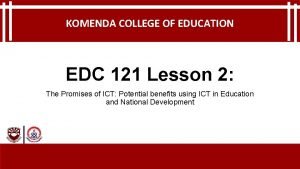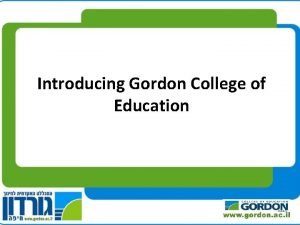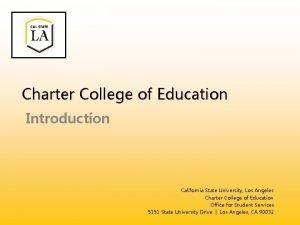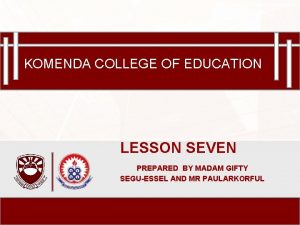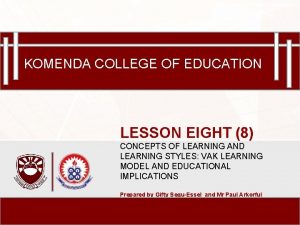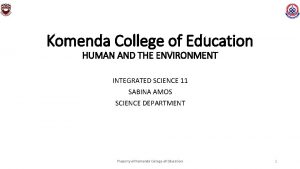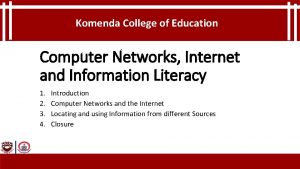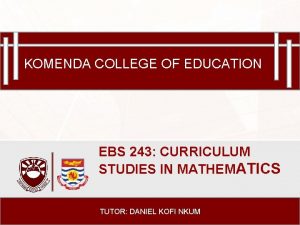Komenda College of Education KOMENDA COLLEGE OF EDUCATION

















- Slides: 17

Komenda College of Education KOMENDA COLLEGE OF EDUCATION LESSON FOUR PREPARED BY MADAM GIFTY SEGU- ESSEL AND MR PAUL ARKORFUL

Komenda College of Education CLICK TO ADD TITLE TOPIC • DOMAINS OF HUMAN DEVELOPMENT (I) There are three domains of human development. • PHYSICAL DEVELOPMENT • COGNITIVE OR INTELLECTUAL DEVELOPMENT

Komenda College of Education CLICK TO ADD TITLE • PHYSICAL DEVELOPMENT These are the growth changes and changes that occur in the persons’ body. The changes include the height, weight, size, bone thickness, muscle, glands, brain and sense organs (eyes, ears, nose etc. )

Komenda College of Education CLICK TO ADD TITLE • COGNITIVE OR INTELLECTUAL DEVELOPMENT Cognitive or intellectual development refers to changes in reasoning, thinking and language development or acquisition. It also refers to how individuals gain, store, retrieve knowledge or acquire information.

Komenda College of Education CLICK TO ADD TITLE • PSYCHOLOGICAL DEVELOPMENT Psychological development is the situation with the changes in feelings or emotions as well as changes in how individuals relate to others. Emphasis is placed on the child’s interaction with his/her environment.

Komenda College of Education CLICK TO ADD TITLE • PHYSICAL GROWTH AND CHANGES WHICH OCCURS DURING INFANCY (BIRTH TO 2 YEARS) • By the end of infancy children develop motor skills such as crawling, sitting, walking, running, jumping etc. • Growth that occurs during infancy stage is very rapid; hence by the end of the fifth month, a child may have doubled both in height and weight. It should be noted that, at birth, boys are generally taller and heavier than girls. • The average weight of infants at birth is about 3. 4 kg with an average height of about 50 cm.

Komenda College of Education CLICK TO ADD TITLE Cont. • Infants can also see and hear but not as perfect as an adult. The notion that some people may have that a child at birth cannot see is false. The only reason that a baby may not blink the eye means that the child’s has not developed cognitively enough to think of eye blinking. • Infants are also able to differentiate different odours as their sense of smell is also well developed at birth. • The head of the baby at birth is about a third of the body.

Komenda College of Education CLICK TO ADD TITLE PHYSICAL GROWTH AND CHANGES DURING CHILDHOOD Childhood period is divided into three main stages. These are: • Early childhood : - from age 2 to 5 years • Middle childhood : - from age 5 to 8 years • Late childhood : - from 8 to 11 years

Komenda College of Education CLICK TO ADD TITLE GROWTH AND CHANGES IN ADOLESCENCE • One major feature associated with adolescence at the early stage is that girls generally mature earlier than boys, but boys are usually heavier than girls. • Adolescence at this stage develops to their maximum height but may not get to their limit in relation to body weight. • At this stage both boys and girls enter into puberty, however, girls usually reach their puberty earlier than boys.

Komenda College of Education CLICK TO ADD TITLE Cont. • Another significant change which occurs in adolescence is the growth of hairs at different parts of the body. For instance, the armpits, around the sexual organs, etc. • Other common feature which distinguishes the adolescent boy from their girl peers is the development of deep voices (boys develop deep voices).

Komenda College of Education CLICK TO ADD TITLE EDUCATIONAL IMPLICATIONS OF PHYSICAL DEVELOPMENT • Teachers should always consider the individual differences of children in relation to their weight, height and body size before assigning tasks to them in the teaching and learning process. • Teachers should create more opportunities and activities for children to facilitate their physical growth and development. • Teachers should always consider the time of maturation between boys and girls in grouping students.

Komenda College of Education CLICK TO ADD TITLE Cont. • Teachers should provide relatively free and flexible activities for such children. Again, at the early stage of writing and drawing, crayons and soft chalk, thick pencils etc. should be used. • Teachers should use script writing to develop their muscles. • Again, when children have mastered the use of their small muscles of the wrist and fingers, cursive writing (jointed letters) can be introduced by teachers as a means of consolidating their physical development.

Komenda College of Education CLICK TO ADD TITLE RITES OF PASSAGES Rites of passage are, therefore the various rites that are performed with the aim of preparing the individual from one stage of life to another, from the cradle to the grave. Eg. Birth rites, puberty rites, marriage rites and death rites.

Komenda College of Education CLICK TO ADD TITLE PUBERTY RITES Puberty rites are rites of initiation ceremony designed to usher an adolescent girl or boy into adulthood. EDUCATIONAL IMPLICATIONS OF PUBERTY RITES • • Puberty rites inculcate sense of respect in girls in the society. It promotes obedience among the adolescents in the society. Puberty rites help to develop the endurance level of adolescents. Puberty rites assist the girls to develop motherliness.

Komenda College of Education CLICK TO ADD TITLE • • • DEVELOPMENTAL TASKS OF ADOLESCENCE Personal identity Striving for independence Striving for emotional maturity Adjusting to new body size and shape Concern for their body image and selfconcept Adjusting to sexuality

Komenda College of Education CLICK TO ADD TITLE Educational implication • Teachers should provide guidance and counselling services in the school for the adolescents. • Teachers must create and provide opportunities that will give adolescents more responsible and independent decision making process. • They should be encouraged to join club and societies. There should be peer educators and peer counsellor trained in the school to help them solve their problems. • The adolescents should be introduced to sports and games.

Komenda College of Education CLICK TO ADD TITLE THANK YOU www. komendacollege. edu. gh
 Struktury policji
Struktury policji Dr komenda
Dr komenda Komenda miejska policji w tarnowie
Komenda miejska policji w tarnowie Tracert parametry
Tracert parametry Wojskowa komenda
Wojskowa komenda Wake tech admissions
Wake tech admissions Early college high school at midland college
Early college high school at midland college College board education pays 2019
College board education pays 2019 Havering college of further and higher education
Havering college of further and higher education Www.foundationsu.com cost of living calculator
Www.foundationsu.com cost of living calculator Bladen community college online classes
Bladen community college online classes Gordon college of education
Gordon college of education Salahaddin university college of science
Salahaddin university college of science Chu hai college of higher education
Chu hai college of higher education Cal state la charter college of education
Cal state la charter college of education Formal and non formal education venn diagram
Formal and non formal education venn diagram Differences between health education and physical education
Differences between health education and physical education Types of extension education
Types of extension education

